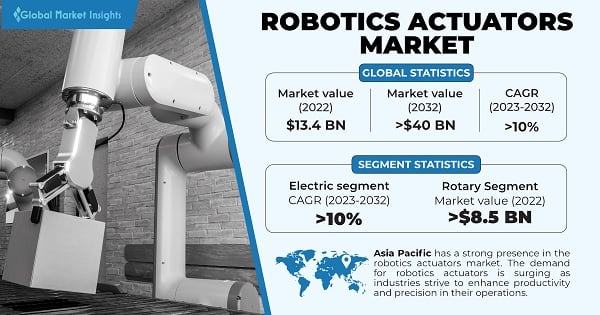Home > Semiconductors & Electronics > Automation > Robotics > Robotics Actuators Market
Robotics Actuators Market Size
- Report ID: GMI6718
- Published Date: Sep 2023
- Report Format: PDF
Robotics Actuators Market Size
Robotics Actuators Market size was valued at USD 13.4 billion in 2022 and is anticipated to grow at a CAGR of over 10% between 2023 and 2032. The industry is driven by the increasing adoption of industrial automation, where in the mechanical components enable the movement & functionality of robots and automated machinery.
In manufacturing, robots equipped with actuators can perform tasks with high precision and speed, leading to improved product quality and productivity. Industries including automotive, electronics, and aerospace have widely adopted robotic automation, fueling the demand for advanced actuators capable of intricate movements. As the concept of Industry 4.0 gains momentum, smart factories and IoT-enabled automation systems are emerging, further propelling the need for advanced actuators. These actuators enable robots to collaboratively work with humans, perform complex tasks, and adapt to dynamic environments, making them indispensable in the evolving the landscape of industrial automation.
| Report Attribute | Details |
|---|---|
| Base Year: | 2022 |
| Robotics Actuators Market Size in 2022: | USD 13.4 Billion |
| Forecast Period: | 2023 to 2032 |
| Forecast Period 2023 to 2032 CAGR: | 10% |
| 2032 Value Projection: | USD 40 Billion |
| Historical Data for: | 2018 to 2022 |
| No. of Pages: | 200 |
| Tables, Charts & Figures: | 647 |
| Segments covered: | Actuation, Characteristics, Type, End-use, & Region |
| Growth Drivers: |
|
| Pitfalls & Challenges: |
|
Robotics actuators are mechanical devices used in robotic systems to create controlled movement. They convert electrical, hydraulic, or pneumatic energy into precise motion, allowing robots to perform tasks such as lifting, rotating, and manipulating objects. Actuators are vital components in various industries, from manufacturing to healthcare, enabling robots to interact with their surroundings and execute programmed actions. These devices come in different types including electric motors, hydraulic cylinders, pneumatic, and pistons, each designed for specific applications in the robotics field.
High installation costs pose significant challenges for the robotics actuators market. While actuators themselves can be expensive, the costs associated with integrating and installing them into robotic systems can be even more substantial. This includes engineering, programming, and customization efforts, as well as the need for skilled labor. These expenses can deter potential buyers, particularly smaller businesses or those with budget constraints, and can lead to longer ROI periods. Therefore, reducing installation costs and simplifying integration processes are crucial to making robotics actuators more accessible and attractive to a wider range of customers.

